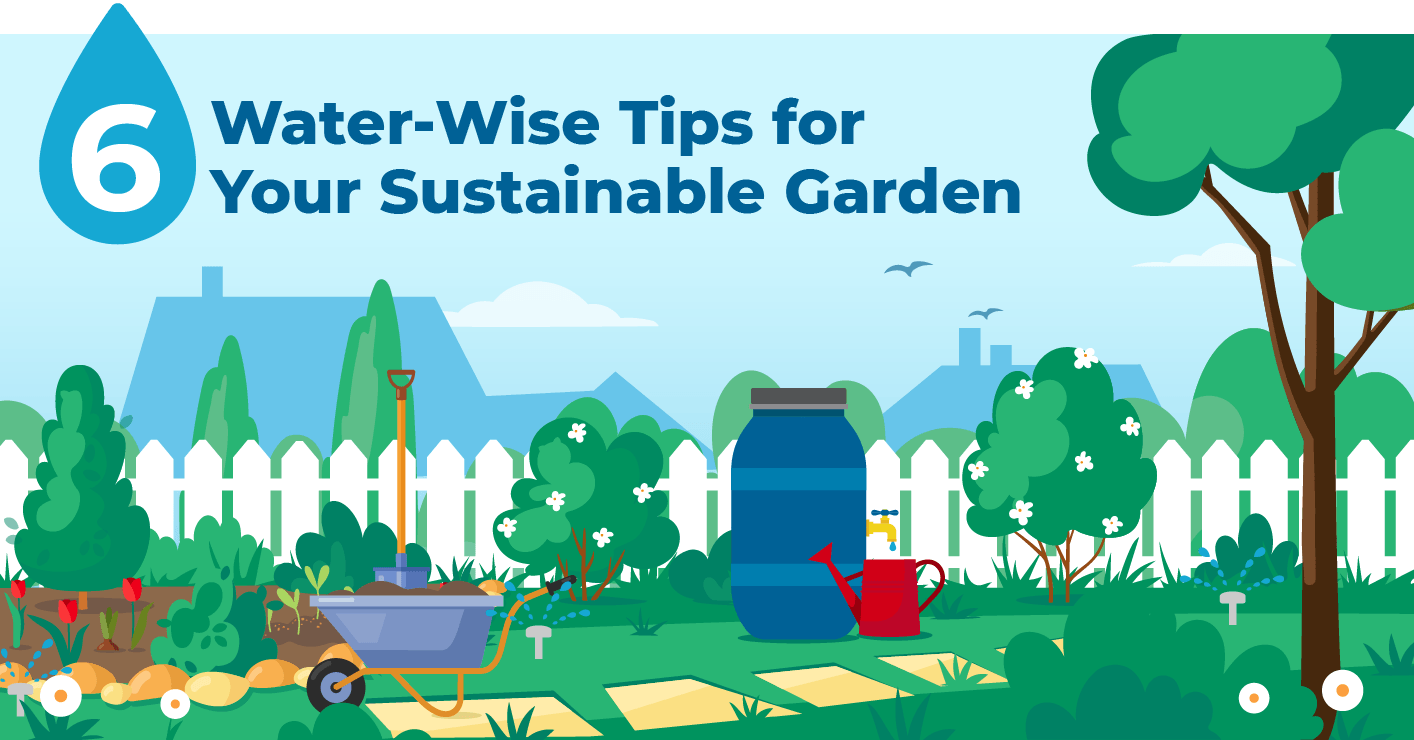Water — we all need it, and so do our gardens. But only a finite amount of it exists, so it’s important to conserve this precious resource. As you cultivate your sustainable garden, make sure you’re in water warrior mode by following these six tips for using H2O responsibly and efficiently.
1. Choose Plants Strategically
If you’re just starting your garden or adding to it, consider plants that are native to your area. These types of plants have already learned how to adapt to the local climate and soil, so they’ve figured out how to use water efficiently. (Talk about first-generation smart technology!) Plus, native plants can often resist pests and diseases better than non-native varieties. Choosing the former means you can spend more time enjoying your garden and less time applying harmful pesticides, herbicides and fungicides.
2. Water at Optimal Times
The time of day you water can make quite a difference in your water conservation efforts. Early morning, between 6 a.m. and 10 a.m., is the best time to water. This gives the water time to soak deep into your plants’ roots before the sun and heat kick in and cause evaporation.
Contrary to popular belief, it’s not recommended to water your garden in the evening after the temperature cools down. Moisture can cling to plant leaves overnight and cause fungal growth or other diseases, which will undo all of your sustainable gardening efforts!
3. Use an Efficient Watering Method
Not-so-fun fact: Experts estimate that as much as 50% of outdoor water use in the U.S. — nearly 4 billion gallons each day — is wasted by inefficiencies in irrigation systems. Although traditional sprinklers have their time and place, to water your garden most efficiently, drip irrigation and soaker hoses are where it’s at.
Drip irrigation uses a system of hoses, nozzles, sprinklers and tubes to deliver a slow and steady drip of water that targets roots directly. Use drip irrigation for delicate plants or those spaced farther apart.
But if the word “system” gives you anxiety, you can always opt for a soaker hose. These garden hoses with tiny holes at intervals offer a similar micro-watering to your plants. Soaker hoses are ideal for plants grown in rows or close together.
Both of these watering options can save a significant amount of water and are widely available for purchase online or at local gardening and home improvement centers.
If you already have an automatic sprinkler system, you can install and connect a smart sprinkler controller for convenient water savings.
4. Say No to Harmful Chemicals
When it comes to harmful pesticides, herbicides and fungicides, it’s always best to avoid them. They can kill helpful insects, disrupt ecosystems and contaminate soil. They can also pollute groundwater, which means less H2O for us all.
Instead, try some more sustainable methods to keep pests, weeds and diseases at bay in your green oasis. Non-chemical strategies include:
- Weeding by hand regularly. (In addition to being eyesores, weeds steal water and other nutrients from your plants.)
- Adding insect traps.
- Introducing natural predators, like ladybugs, lacewings and praying mantises.
- Growing companion plants together. (An example: Basil, dill and thyme planted near tomatoes all help repel harmful pests.)
- Pruning frequently. (This removes weak, disease-prone leaves and shoots that restrict healthy airflow to healthier parts of the plant.)
- Using natural store-bought or homemade spray.
5. Say YES to Mulch and Compost
Mulch and compost are a gardener’s best friends and help with water conservation, in addition to many other benefits. Used together, mulch and compost pack a one-two punch for maximizing water efficiency.
This, in turn, helps the soil retain moisture and reduces evaporation, so you don’t have to water as often. For Texans and others in very hot climates, this is an especially helpful water-saving tactic.
Adding compost to your soil, meanwhile, improves the latter’s quality and its ability to absorb and store water. The fact that it’s nicknamed “black gold” shows just how valuable compost can be for gardens. You can even make your own compost to save money and put a significant amount of your household food scraps, yard waste and more to good use. Win. Win. Win.
6. Collect and Reuse Rainwater
A rain barrel placed strategically under a downspout collects water that can be recycled in a number of ways, including:
- Watering flowers, houseplants and your compost pile
- Washing your car or windows
- Refilling birdbaths, koi ponds and other outdoor water features
- Rinsing your hands and garden tools
Opinions seem to be split on whether it’s safe to use collected rainwater on plants you will eat, since it runs off your roof and likely contains animal bacteria and chemicals from shingles. If you’re interested in using your rainwater on your veggies, fruits and herbs, first research proper rain barrel cleaning and maintenance best practices. And always use rainwater in the soil — not on the plant itself. Better safe than sorry!
By focusing on responsible water use in your garden, you can minimize water waste and make it even more sustainable for years to come. And now that you have a green game plan for your garden, take your sustainable living one step further with a clean energy plan for your home.
GET INVOLVED: Green Mountain Energy Earth Day returns to Discovery Green on Saturday, April 20 from noon to 5 pm. This year’s Earth Day will be about using art to engage people and urge them to action. Just as anyone can be an artist, anyone can be an activist. At Earth Day, you can be both! Expect art installations, activities, performances, short documentary films and more than 60 exhibitors.



